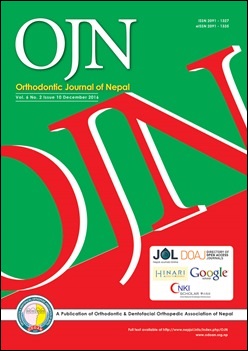Role of CBCT in diagnosis and treatment plan of Impacted teeth: A Case Report
DOI:
https://doi.org/10.3126/ojn.v6i2.17421Keywords:
CBCT, Impacted canine, OrthodonticsAbstract
In recent years Cone Beam Computed Tomography (CBCT) has become a widely accepted radiographic tool for diagnosis, treatment planning and follow-up in dentistry. 3D imaging has improved diagnostic efficiency and the practice of dentistry in a variety of ways; from routine evaluation to complex analysis of unusual pathology and congenital deformities. The technology available today makes dentistry better, easier, and more accurate. The most recognized need for CBCT imaging in orthodontics is that of the impacted canine evaluation. This article reports a patient having impacted right maxillary lateral incisor and canine; which is evaluated by 3D CBCT and was found beneficial particularly in terms of anatomical detail of root resorption and labiolingual relationships of the impacted tooth with the roots of neighboring teeth. Linear and angular measurements on CBCT images were accurate and helped in determining the exact location of the impacted teeth making it convenient for the surgical exposure of impacted teetDownloads
Download data is not yet available.
Abstract
962
PDF
1877
Downloads
Published
2016-12-31
How to Cite
Pradhan, D., & Tian, T. (2016). Role of CBCT in diagnosis and treatment plan of Impacted teeth: A Case Report. Orthodontic Journal of Nepal, 6(2), 41–44. https://doi.org/10.3126/ojn.v6i2.17421
Issue
Section
Case Reports
License
Copyright © held by Orthodontic & Dentofacial Orthopedic Association of Nepal
- Copyright on any research article is transferred in full to the Orthodontic & Dentofacial Orthopedic Association of Nepal upon publication in the journal. The copyright transfer includes the right to reproduce and distribute the article in any form of reproduction (printing, electronic media or any other form).
- Articles in the Orthodontic Journal of Nepal are Open Access articles published under the Creative Commons CC BY License (https://creativecommons.org/licenses/by/4.0/)
- This license permits use, distribution and reproduction in any medium, provided the original work is properly cited.




